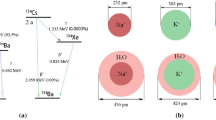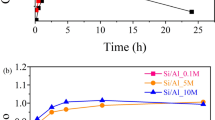Abstract
Electron spin resonance (ESR) analysis of Cu2+-hectorite suspensions provides evidence for the surface-induced hydrolysis of Cu(H2O)62+ at low pH and surface-inhibited hydrolysis (or precipitation) at high pH. Dehydration of the hectorite by heating to 110°C appears to promote hydrolysis in high pH clays further. Heating to even higher temperatures removes ligand water from Cu2+, allowing the metal ion to coordinate with silicate oxygen atoms. The planar Cu(H2O)42+ ion predominates in the interlamellar regions of hectorite that has been air dried or heated to temperatures of 110°C or lower, but more extreme thermal treatment changes the apparent orientation of the Cu2+-ligand axes as some or all of the four water ligands are removed, A loss in ESR signal intensity upon heating Cu2+-hectorite above 110°C is evidence for lowered symmetry of the dehydrated, surface-coordinated Cu2+ ion.
Резюме
Посредством эдектронного спинового резонанса (ЭСР) суспензий Cu2+-гекторит получено доказательство для существования поверхностно-индуктированного гидролиза Cu(H2O)62+ при низких pH и поверхностно-ингибиторного гидролиза (или осаждения) при высоких рН. Дегидратация гекторита при нагреве до 110°C приводит к активации гидролиза в глинах с высоким pH, дальнейший обогрев до высоких температур удаляет лиганд воды из Cu2+, позволяя иону металла координировать с атомами кислорода силиката. Плоскостный ион Cu(H2O)42+ преобладает в межламельных зонах гекторита, который сушился на воздухе либо обогревался до 110°С или низшей температуры. Более предельная сверхтермическая обработка изменяет кажущуюся ориентацию осей лиганда Cu2+ по мере того как некоторые либо все из четерех лигандов воды удалены. Потеря интенсивности сигнала ЭСР при обогреве Cu2+-гекторита свыше 110°C является доказательством для обнижения симметрии дегидратированного поверхностно-координированного иона Cu2+. [E.C.]
Resümee
Die Electronenspinnresonanz-Analyse (ESR) von Cu2+-Hektorit-suspensionen zeigen, daß eine durch die Oberfläche geförderte Hydrolyse yon Cu(H2O)62+ bei niedrigen pH-Werten und eine durch die Oberfläche verhinderte Hydrolyse (oder Ausfällung) bei hohen pH-Werten stattfindet. Die Dehydratation des Hektorit durch Erhitzen auf 110°C scheint die Hydrolyse in Tonen mit hohem pH weiter zu fördern. Beim Erhitzen auf noch höhere Temperaturen wird das Ligandenwasser yon Cu2+ entfernt, wodurch sich das Metallion mit Silikatsauerstoffatomen koordinieren kann. Das planare Cu(H2O)42+-Ion ist in den interlamellaren Bereichen von Hektorit, der Luft getrocknet oder bis maximal 110°C erhitzt wurde, vorherrschend. Eine Erhitzung auf höhere Temperaturen verändert jedoch die Orientierung der Cu2+-Ligandenachsen, da einige oder alle der vier Wasserliganden entfernt werden. Eine Verminderung der ESR-Signalitensität nach dem Erhitzen yon Cu2+-Hektorit über 110°C zeigt die Symetrieverringerung der dehydratisierten Oberflächen-koordinierten Cu2+-Ionen. [U.W.]
Résumé
L’analyse par resonance à spin d’électrons de suspensions d’hectorite-Cu2+ fournit l’évidence pour l’hydrolyse induite à la surface de Cu(H2O)62+ à un pH bas, et pour l’hydrolyse inhibée à la surface (ou pour la précipitation) à un pH élevé. La déshydration de l’hectorite par échauffement à 110°C semble d’avantage promouvoir l’hydrolyse dans des argiles à pH élevé. L’échauffement à des températures encore plus élevées enléve l’eau ligande de Cu2+, permettant une coordination de l’ion métal avec des atomes oxygènes silicates. L’ion Cu(H2O)42+ plane domine dans les régions interfolaires de l’hectorite sechée à l’air ou échauffée à 110°C ou à des températures plus basses, mais un traitement thermal plus extèeme change l’orientation apparente des axes ligands Cu2+ puisque certains ou tous les quatre ligands aqueux sont retirés. Une perte d’intensité du signal ESR lorsque l’hectorite est chauffée au delà de 110°C est une preuve de la symmétrie amoindrie de l’ion Cu2+ déshydraté coordonné à la surface. [D.J.]
Similar content being viewed by others
References
Baes, C. F. and Mesmer, R. E. (1976) The Hydrolysis of Cations: Wiley, New York, 489 pp.
Bloom, P. R., McBride, M. B., and Chadbourne, B. (1977) Adsorption of aluminum by asmectite: I. Surface hydrolysis during Ca2+-Al3+ exchange: Soil Sci. Soc. Amer. J. 41, 1068–1073.
Clementz, D. M., Pinnavaia, T. J., and Mortland, M. M. (1973) Stereochemistry of hydrated copper(II) ions on the interlamellar surfaces of layer silicates. An electron spin resonance study: J. Phys. Chem. 77, 196–200.
Conesa, J. C. and Soria, J. (1978a) Electron spin resonance of dipole-coupled copper(II) pairs in Y zeolites: J. Phys. Chem. 82, 1575–1578.
Conesa, J. C. and Soria, J. (1978b) Electron spin resonance of undetected copper(II) ions in Y zeolites: J. Phys. Chem. 82, 1847–1850.
Farrah, H. and Pickering, W. F. (1976a) The sorption of copper species by clays. I. Kaolinite: Aust. J. Chem. 29, 1167–1176.
Farrah, H. and Pickering, W. F. (1976b) The sorption of copper species by clays: II. Illite and montmorillonite: Aust. J. Chem. 29, 1177–1184.
Kivelson, D. and Neiman, R. (1961) ESR studies on the bonding in copper complexes: J. Chem. Phys. 35, 149–155.
McBride, M. B. (1978) Copper(II) interactions with kaolinite: factors controlling adsorption. Clays & Clay Minerals 26, 101–106.
McBride, M. B. and Mortland, M. M. (1974) Copper(II) interactions with montmorillonite: Evidence from physical methods: Soil Sci. Soc. Amer. Proc. 38, 408–415.
McBride, M. B., Pinnavaia, T. J., and Mortland, M. M. (1975) Electron spin resonance studies of cation orientation in restricted water layers on phyllosilicate (smectite) surfaces: J. Phys. Chem. 79, 2430–2435.
Mortland, M. M. and Raman, K. V. (1968) Surface acidity of smectites in relation to hydration, exchangeable cation, and structure: Clays & Clay Minerals 16, 393–398.
Turner, R. C. and Brydon, J. E. (1965) Factors affecting the solubility of Al(OH)3 precipitated in the presence of montmorillonite: Soil Sci. 100, 176–181.
Author information
Authors and Affiliations
Additional information
Contribution No. 1408.
Rights and permissions
About this article
Cite this article
McBride, M.B. Hydrolysis and Dehydration Reactions of Exchangeable Cu2+ on Hectorite. Clays Clay Miner. 30, 200–206 (1982). https://doi.org/10.1346/CCMN.1982.0300306
Received:
Accepted:
Published:
Issue Date:
DOI: https://doi.org/10.1346/CCMN.1982.0300306




